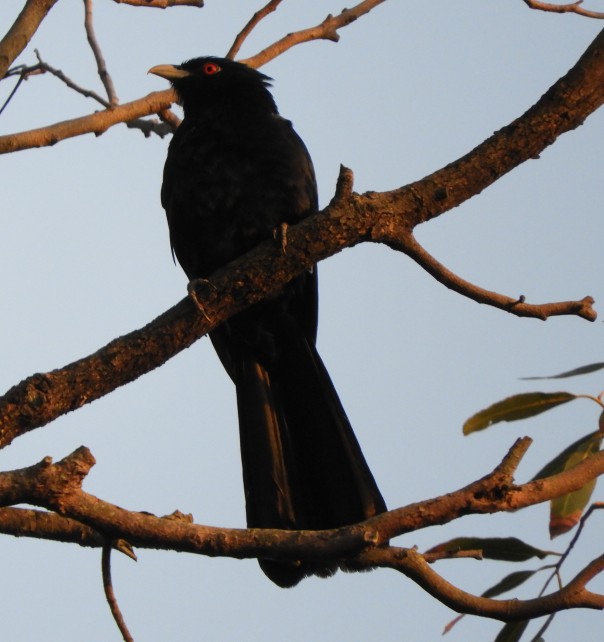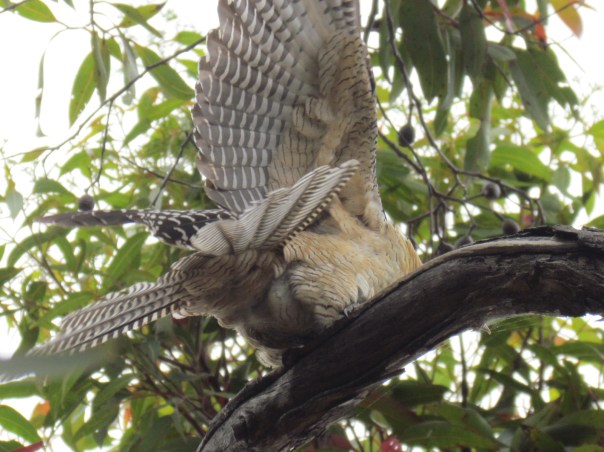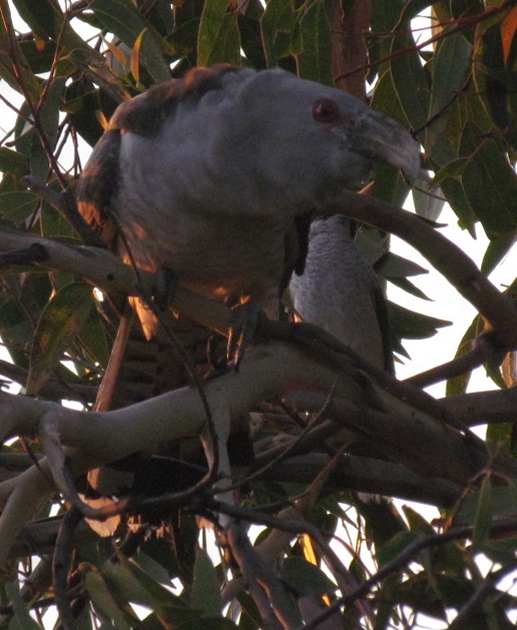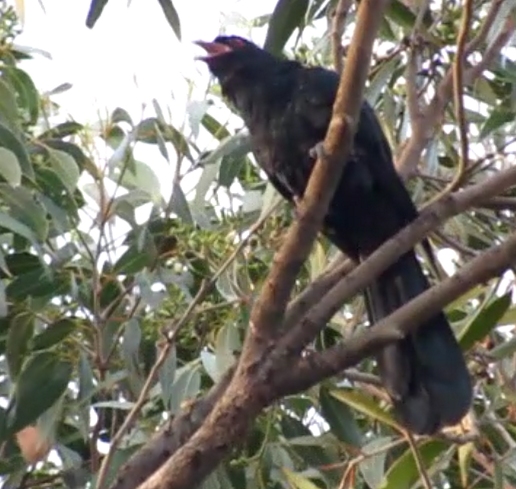Blog Archives
Big baby! Koel cuckoo fed by Red Wattlebird
It’s cuckoo season here on the east coast of Australia. We have several types of cuckoos that migrate to our shores for the summer months and get the local birds to feed their young. That’s right! Cuckoos lay their eggs in some other bird’s nest and fly away free as a … well, as a bird. The adoptive parent is often much smaller than the baby cuckoo, but it’s hornswoggled into feeding the youngster until the cuckoo is old enough to take care of itself.
One of the cuckoos that come to our shores is the Common Koel, also called the Eastern Koel. A couple of days ago, I saw a young Koel being fed by a Red Wattlebird:
In the video, you can hear the juvenile Koel chirping repeatedly, begging for food.
Here’s a photo of the big baby:

Adult Koels make quite a variety of sounds, including loud squawks and more melodic whistles. You can hear them in the video in this post. And you can see some shots of male and female adult Koels in other posts.
Common name: Common Koel, Pacific Koel, or Eastern Koel
Scientific name: Eudynamys orientalis (was scolopacea)
Approximate length: 45 cm
Date spotted: 3 December 2025 (summer)
Location: Manly Dam Park, New South Wales, Australia: 33°46’57.5″S 151°15’20.8″E
Male Koel Cuckoo in shot at last
Recently I’ve managed to snap a few shots of female Eastern Koels, also called Common Koels or Koel Cuckoos. Now a male has come into my sights:
While the female is rather pretty, with shades of cream and brown overlaid with stylish spots, the male is primarily black. In fact, this photo shows more variation in colour than usual, because of the soft morning light.
If you’d like to see some shots of the females, or hear some of the cuckoos’ calls, take a look at this list of posts.
Common name: Common Koel or Eastern Koel
Scientific name: Eudynamys scolopacea
Approximate length: 45 cm
Date spotted: 28 December 2018 (Summer)
Location: Allambie Heights, New South Wales, Australia
Female Koel cuckoo
Koel cuckoos have been swooping and calling around our house the last couple of days. They arrive in this neck of the woods in spring and head off again for northern climes in autumn. While here, they lay eggs in another bird’s nest and leave it up to the host family to feed the youngster. Typical cuckoo.
This is a female Koel cuckoo. They’re impressive to look at, and quite decorative in contrast to the completely-black male of the species.
An earlier post shows a male Koel cuckoo, and you can play the video in that post to hear their call.
Common name: Common Koel or Eastern Koel
Scientific name: Eudynamys scolopacea
Approximate length: 45 cm
Date spotted: 10 November 2018 (spring)
Location: Allambie Heights, NSW, Australia
Koel Cuckoo regurgitates food
Today I spotted a young female Koel Cuckoo. The males are so dark in colour that it’s hard to see them in fine detail. Photographs end up being just a black blob. But this female is quite pretty.
This video shows the bird sitting quietly on the branch, not doing much. At around 20 seconds into the video, she regurgitates some fruit and then swallows it again.
Adult Koel Cuckoos have red eyes, but youngsters can keep the brown colour into their second summer. I thought I glimpsed a glint of red every now and then, but her eyes are still mostly dark brown.
Here’s another side view of her, sheltering behind the foliage:
She decided to stretch her wings. I was behind her at the time, so there’s a lovely view of soft down and the underside of her wings:
Common name: Common Koel or Eastern Koel
Scientific name: Eudynamys scolopacea
Approximate length: 45 cm
Date spotted: 27 November 2016
Season: Spring
Location: Manly Dam Reserve, New South Wales, Australia
Latitude/longitude: 33°46’35.6″S 151°15’16.8″E
Cuckoos are back in town
They’re noisy creatures, but I love it when the cuckoos arrive in Sydney. They herald the start of spring. They also send the local birds into a tizzy. Territorial disputes abound. The kookaburras have a rival for their 5am wake-up duties. And the noisy miners have another large bird to terrorise.
The cuckoos are migratory, spending the warmer half the year in Australia and the cooler half in Indonesia, Papua New Guinea and other northern climes. Two types of cuckoos make themselves known in our neighbourhood by their loud calls: the Channel-billed Cuckoos and the Koel Cuckoos.
Channel-billed Cuckoo
The Channel-billed Cuckoos are the largest cuckoos in the world. With their red eyes and large beaks, they’re an impressive sight. Today I was lucky to see one reasonably close by, and I was amazed by the way it moves. This one was being bothered by a noisy miner. The cuckoo was constantly bending and wriggling its neck to try and spot its tormentor. At the end of the video, you’ll see it looking up in alarm then disappearing with a flash of its tail, as the much smaller miner dive-bombs it.
Here’s a still photo of the same cuckoo peering out from underneath a canopy of leaves:
In this one, the cuckoo is looking reasonable relaxed but on the alert for attack:
And here it’s definitely wary:
Common name: Channel-billed Cuckoo
Scientific name: Scythrops novaehollandiae
Approximate length: 58-65 cm
Date spotted: 1 November 2015
Season: Summer
Location: Allambie Heights, New South Wales, Australia
Latitude/longitude: 33°46’13.9″S 151°15’39.2″E
Koel Cuckoo
Then there are the Koel Cuckoos, like this one who came calling recently:
Here’s a photo of the Koel Cuckoo in full throat:
Common name: Common Koel or Eastern Koel
Scientific name: Eudynamys scolopacea
Approximate length: 45 cm
Date spotted: 11 October 2015
Season: Summer
Location: Allambie Heights, New South Wales, Australia
Latitude/longitude: 33°46’13.9″S 151°15’39.2″E










